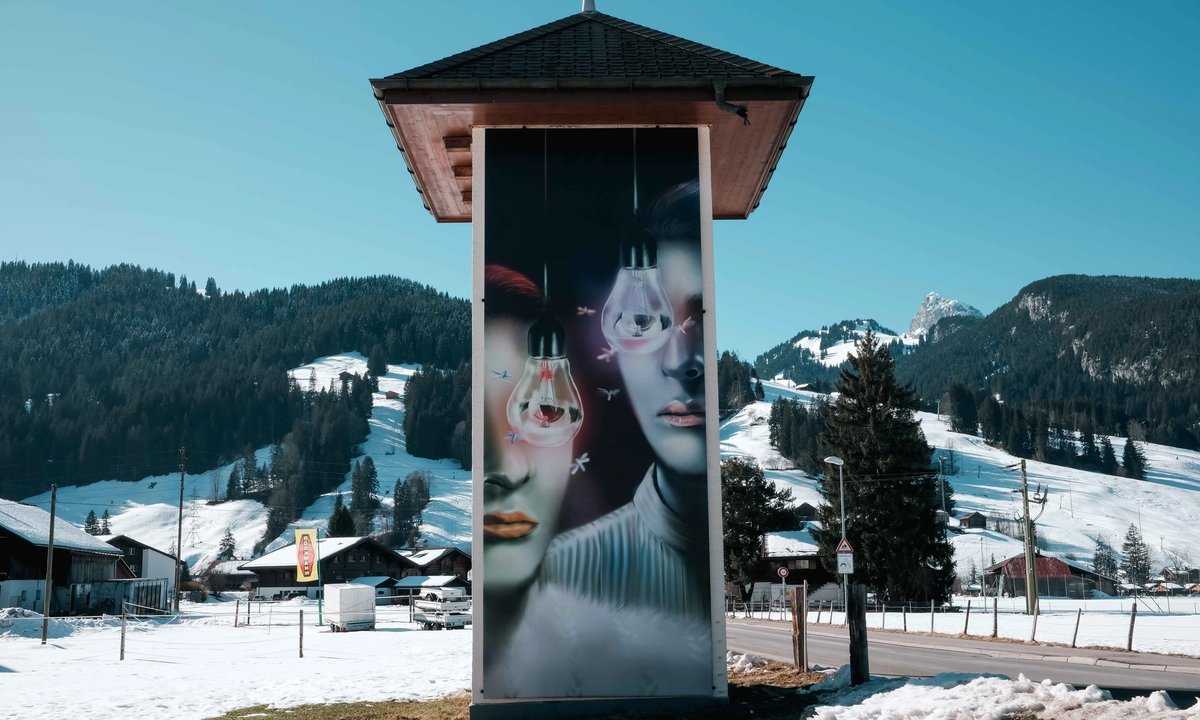Louisa Gagliardi’s Electric Company (2025) Courtesy the artist. Photo: Mario Biermann
It is difficult to immediately locate the sense of crisis in Gstaad. Wander around the exclusive Alpine town in south-western Switzerland and you will see glitzy private planes soar overhead, tourists decked out in designer skiwear, and pristine chalets nestled in light blankets of snow. Even some of the dogs wear shiny pink coats.
And yet this “billionaire’s playground”, is not, in fact, immune to some of the desperate realities of the present moment. Since 1970, annual snow cover duration in the Swiss Alps has reduced by 38 days. Alpine glaciers, meanwhile—crucial sources of nutrients for our seas and rivers—have lost up to 65% of their volume since 1850, and it is predicted that they may disappear altogether by the end of the century. The leading cause of all of this is human activity, in particular the burning of fossil fuels such as oil, coal and gas.
It is fitting, then, that the latest edition of Elevation 1049, the art festival produced by the Swiss collector Maja Hoffman’s Luma Foundation and hosted regularly in Gstaad for nearly a decade, should be themed around Energies. The show, which is an adapted version of a show held at the Swiss Institute in New York, features works by 13 artists and collectives exploring our relationship to this topic in both a literal and metaphorical sense. Across two indoor venues, and out in the snowy landscape, the wonder, carelessness and cruelty of how we handle energy is laid bare.
Among the most memorable works in the exhibition, curated by the Swiss Institute’s director Stefanie Hessler, is Himali Singh Soin’s film Static Range. It responds to an astonishing story about a radio telemetry spy device abandoned in the Indian Himalayas by the CIA. Since then the object—which has almost half of the plutonium present in the atomic bomb dropped on Hiroshima in 1945—has been leaking radioactive energy into the rocky landscape, with unexplained cases of cancer arising among the local Sherpa community.
Still from Himali Singh Soin, Static Range (2020-ongoing)
Courtesy of Elevation 1049
In Static Range, an imagined letter from the device to the mountain is played over a shifting, iridescent image of the mountain Nanda Devi, depicted on a postage stamp. “If you are a monument then I am violent, slowly violent, not the slowness that is the state of rest or thankfulness but the kind that feels like a fever in the heart, one that leaks into ritual, into belief,” the narrator says, menace dripping from her voice. A soundtrack of nagada drums, local to the region, plays like a statement of defiance behind her.
Other interplays of power appear throughout the show. The Congolese artist Jean Katambayi Mukendi presents a series of Afrolampe drawings—bold, semi-abstracted renderings of lightbulbs created with pen, compass and ruler on graph paper. They respond to a contradiction: the Democratic Republic of Congo is one of the biggest exporters of refined copper, a material used globally in the production of green technology such as solar panels, yet many in the city of Lubumbashi, where the artist lives, experience regular power outages. Their titles, meanwhile, such as Covid Afrolampe 23, nod to other resource inequalities between the Global North and South.
Jean Katambayi Mukendi, Covid Afrolampe 23 10h30 (2022)
Photo: Dario Lasagni
These imposing, morphing shapes with their schematic backgrounds seem to map out the systems that govern us. In a second space Mukendi presents Voyant, a robot made from cardboard, paper and handmade electrical wiring—suggestive, perhaps, of the ways one can break free.
Instar (6.9kwh), meanwhile, by the Swedish artist Vibeke Mascini, is an installation centred around a radiator plugged into a large battery pack. That battery pack uses energy generated by the burning of cocaine confiscated in the Netherlands—a process the artist gained special access to and that feeds into the electricity sources of the country’s general population.
Installation view of Vibeke Mascini, INSTAR, 6.9kWh (2024/25)
Photo: Mario Biermann
The artist, speaking during the show’s preview, points to the positive results of this exchange: butterfly pupae hang from a second radiator, their inhabitants having made a nest in the warmth during a previous iteration of the project. In Gstaad, she adds, the electricity is “bringing us some heat and we’re taking that energy with us as we go.”
It is, naturally, more complex and engaging than that too. Given this is a power source inextricably tied to the global drug trade, there are darker layers within it, such as histories of exploitation and violence. “I’m inevitably thinking of what lingers in this energy,” Mascini tells The Art Newspaper separately.
It is hard to shake the strangeness of seeing some of these issues addressed in Gstaad, known as a getaway for some of the most privileged individuals: royals, Hollywood actors, business magnates.
This is a contradiction that has clearly not escaped the exhibiting artists, and of those present on the day, Chicago-based Theaster Gates, known for his socially engaged practice, is perhaps most candid in his reference to it.
“To be honest, Gstaad and [fellow Swiss luxury resort] St Moritz, they're places that are a little bit far in my imagination,” he says. “These places are kind of signifiers of a certain kind of lifestyle, or a certain kind of wealth, or a certain kind of opportunity. I was afraid that when I got here, I would feel horribly out of place.”
He explains, however, that what he found was the opposite. “Because I have my friends and because I have my friendship with Maja Hoffmann, I feel like I'm actually enveloped in this community,” he says. “I feel like when I'm moving through the mountains, I'm surrounded by love. When I sit down at the dinner table, I'm surrounded by love. And so it’s been hard not to like relax my shoulders a bit. It's like—oh, this is actually okay.”
Such positivity is uplifting, and typical of Gates, whose work often harnesses the energy that emerges from acts of collaboration. In Energies, there are ceramic studies on display that were created in a workshop he has put together at Luma’s outpost in Arles in the south of France. On the opening night, he performed at Gstaad Saanen airport—reserved for private aircraft—with his band the Black Monks, whose music combines the sound of blues, gospel and more with a use of repetition inspired by Eastern monastic traditions.
Theaster Gates and the Black Monks perform at Gstaad airport
Photo: Mario Biermann
The concert was mesmerising, one of the most compelling examples of art as energy you could hope to witness. It took place, however, in front of an intimate crowd filled with VIPs—the celebrity chef Massimo Bottura and the Monégasque royal Andreas Casiraghi among them—and with landing helicopters and jets visible through the monumental glass shutters behind the musicians.
And so a question inevitably arises that could be applied to the show as a whole: who is this for? Given Gstaad is only home to around 9,000 people (or 20,000 in high season) and a three-hour train ride from Geneva, what can be done to give more people access?
Hoffmann certainly has ambitions in this regard. Giving a speech outside the Station, one of the exhibition’s two main venues, she says she wishes to expand Elevation 1049 to St Moritz and turn it into the “biennial of the Alps”. A—quite literally—lofty premise, though one that does tap into Luma’s drive to create new platforms for boundary pushing, socially engaged art.
Hessler, for her part, argues that holding the exhibition in Gstaad “is really valuable”. Speaking of exhibits such as Mukendi’s, she continues: “In Europe, often it can feel like partially, at least, we are moving towards green energy, but I feel that conversation needs to be a lot more nuanced, where we actually look at what that means, and who benefits from that and who doesn’t”. It is arguable, too, that engaging the world’s most affluent and powerful people is one way to encourage genuine change.
If this region is to become home to a successful event long term, though, further thinking is needed. Another highlight of Energies is Maria Loizidou’s four hanging tapestries, each featuring depictions of different birds from France—swallows, robins, flamingos and hoopoes—whose migratory patterns are threatened by climate change. Each have been made using a Mediterranean technique involving steel wire—and intricately woven by eight people over a two-year period.
These works are magnificent. This show, in its concise and excellent mix of perspectives, is too. All efforts must now be on ensuring that future editions, and their warnings, reach a wider audience, before their potency is lost under delicate carpets of snow.
Exhibition at Hauser & Wirth in Gstaad, Switzerland, shows images captured by the war photographer David Douglas Duncan
Artist sets up printing press in Basel to explore ‘Black Madonna’ theme

